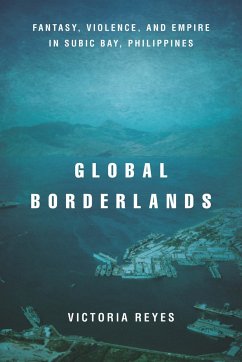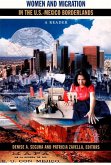- Broschiertes Buch
- Merkliste
- Auf die Merkliste
- Bewerten Bewerten
- Teilen
- Produkt teilen
- Produkterinnerung
- Produkterinnerung
The U.S. military continues to be an overt presence in the Philippines, and a reminder of the country's colonial past. Using Subic Bay (a former U.S. military base, now a Freeport Zone) as a case study, Reyes argues that its defining feature is its ability to elicit multiple meanings.
Andere Kunden interessierten sich auch für
![Color-Line to Borderlands Color-Line to Borderlands]() Color-Line to Borderlands37,99 €
Color-Line to Borderlands37,99 €![Gender on the Borderlands Gender on the Borderlands]() Gender on the Borderlands40,99 €
Gender on the Borderlands40,99 €![Women and Migration in the U.S.-Mexico Borderlands Women and Migration in the U.S.-Mexico Borderlands]() Women and Migration in the U.S.-Mexico Borderlands49,99 €
Women and Migration in the U.S.-Mexico Borderlands49,99 €![Girlhood in the Borderlands Girlhood in the Borderlands]() Lilia SotoGirlhood in the Borderlands38,99 €
Lilia SotoGirlhood in the Borderlands38,99 €![Religious Revival in the Tibetan Borderlands Religious Revival in the Tibetan Borderlands]() Koen WellensReligious Revival in the Tibetan Borderlands40,99 €
Koen WellensReligious Revival in the Tibetan Borderlands40,99 €![Race, Gender, and the Politics of Skin Tone Race, Gender, and the Politics of Skin Tone]() Margaret L HunterRace, Gender, and the Politics of Skin Tone76,99 €
Margaret L HunterRace, Gender, and the Politics of Skin Tone76,99 €![Human Rights of the Third Gender in India Human Rights of the Third Gender in India]() Lopamudra SenguptaHuman Rights of the Third Gender in India37,99 €
Lopamudra SenguptaHuman Rights of the Third Gender in India37,99 €-
-
-
The U.S. military continues to be an overt presence in the Philippines, and a reminder of the country's colonial past. Using Subic Bay (a former U.S. military base, now a Freeport Zone) as a case study, Reyes argues that its defining feature is its ability to elicit multiple meanings.
Hinweis: Dieser Artikel kann nur an eine deutsche Lieferadresse ausgeliefert werden.
Hinweis: Dieser Artikel kann nur an eine deutsche Lieferadresse ausgeliefert werden.
Produktdetails
- Produktdetails
- Verlag: Stanford University Press
- Seitenzahl: 312
- Erscheinungstermin: 3. September 2019
- Englisch
- Abmessung: 223mm x 150mm x 21mm
- Gewicht: 426g
- ISBN-13: 9781503609419
- ISBN-10: 1503609413
- Artikelnr.: 53545019
- Herstellerkennzeichnung
- Libri GmbH
- Europaallee 1
- 36244 Bad Hersfeld
- gpsr@libri.de
- Verlag: Stanford University Press
- Seitenzahl: 312
- Erscheinungstermin: 3. September 2019
- Englisch
- Abmessung: 223mm x 150mm x 21mm
- Gewicht: 426g
- ISBN-13: 9781503609419
- ISBN-10: 1503609413
- Artikelnr.: 53545019
- Herstellerkennzeichnung
- Libri GmbH
- Europaallee 1
- 36244 Bad Hersfeld
- gpsr@libri.de
Victoria Reyes is Assistant Professor of Sociology at University of California, Riverside.
Contents and Abstracts
Introduction
chapter abstract
This chapter introduces the concept of global borderlands, places
controlled by foreigners where the rules that govern socioeconomic life
differ from those that are outside its walls and places that elicit
multiple meanings. Global borderlands are proliferating around the world.
and in examining Subic Bay, Philippines-a former military base and now a
Freeport Zone-this chapter highlights how they are sites of contestation
and contradictions, where sovereignty is contingent, meanings and
identities are continually remade, and inequality serves as their
foundation.
1Money and Authority
chapter abstract
This chapter examines the push and pull of political negotiations through
an analysis of military agreements, tax law, and tax disputes. It focuses
on how inequality is written into the foundation of these places through
legal negotiations and the conflicts they spark on the ground. However, it
also shows how Filipinos have increasingly found ways to exploit the
language of these documents to assert sovereignty, though they do so with
varying levels of success. The chapter shows how, in these negotiations,
sovereignty is negotiated in the minutiae of who has control over territory
versus who has control in the administration over people and facilities, or
what Reyes calls administrative sovereignty, allowing Filipinos and
foreigners alike to stake a claim and view these negotiations through a
lens of success.
2Rape and Murder
chapter abstract
This chapter lays out the stakes involved in global borderlands by
examining two high-profile crimes: a rape and a murder, both of which were
committed by U.S. servicemen against Filipinas. In these two cases,
activists, judges, lawyers, and reporters use sexual violence as a vehicle
and a proxy for making broader sociopolitical critiques about the
relationship between the United States and the Philippines, and the effect
that relationship has on the Philippines as a sovereign nation-state. This
chapter shows how small, seemingly minute details-such as negotiations over
where and under what conditions the culprits are held, who controls access
to them, and who stipulates the terms of their detention-are where power
dynamics between the United States and the Philippines can be seen.
3Sex and Romance
chapter abstract
The global borderlands of active and decommissioned overseas U.S. military
bases often conjure up images and sexual fantasies of local women at the
beck and call of men, ready to indulge in their every desire. This chapter
juxtaposes two alternative and competing understandings of the
relationships between U.S. servicemen and Filipinas, as being wrought with
violence, inequality, and exploitative sex versus being imagined in romance
and seen through the lens of a heroic love myth. It shows how these
relationships and the myths that surround them are regulated formally and
informally, and it is precisely because they are both prevalent and at odds
with one another that they contribute to the staying power of global
borderlands.
4Born in the Shadows of Bases
chapter abstract
This chapter turns its focus to Amerasians (children of U.S. servicemen and
Filipina women), their place in Philippine and U.S. societies, and the
conditions in which they thrive rather than barely survive. It shows how
the intimate sphere of the family and home is affected by the political and
economic relationships between countries. Multiple and competing laws and
understandings governing morality and imaginaries of belonging affect the
relationships created in Subic Bay. Yet even concerning familial relations,
global borderlands do not all operate in the same way. U.S. military bases
vary regarding familial laws and policies because place-its geography,
sociocultural meanings, and use-matters. Because Subic Bay became a place
linked to soldiers' respite from the Vietnam War, whether intended or
otherwise, its affect on thousands, if not millions, of children around the
world is unique.
5Labor and Imagined Identities
chapter abstract
This chapter uses employment as a lens to examine how people on the ground
experience Subic Bay. Focusing on the U.S. Subic Bay Naval Base as an
employer and two businesses within the Subic Bay Freeport Zone-the
Filipino-owned, upscale Harbor Point mall and the South Korean company
Hanjin Shipping-the chapter shows how people understand national identities
and inequalities through what Reyes calls labor imaginaries. That is, it
shows how the experiences and reputations of employers and customers
recreate utopian imaginaries and others-those based on human rights
violations, hell, and poverty-and how people link them to their
understandings of what it means to be a foreigner of a particular
nationality.
6Buying Inequality
chapter abstract
This chapter focuses on the Filipino and foreign men and women who work in,
live in, and visit the Subic Bay Freeport Zone. Many people see the
Freeport Zone as a continuation of the U.S. military past and a symbol of
the future, providing ways to live the good life and be part of a modern
global community. One way to become a part of this modern utopia is through
consumption imaginaries, buying into this world through everyday purchases.
Through these everyday purchases, people recreate symbolic and tangible
stratification between classes and nationalities. However, these
imaginaries do not always reflect reality on the ground. Corruption, crime,
and intimidation also infiltrate the Freeport Zone and perpetuate
inequality.
Conclusion
chapter abstract
The conclusion reflects on the reasons that global borderlands are a
central object of study for the twenty-first century: they are the
landscapes in which international tensions arise. Global borderlands
simultaneously evoke a sense of a global modernity and are symbols of
foreign powers' penetration into domestic societies. As such, they are the
battlegrounds of international politics, as we see in contemporary
political debates around free trade and global integration in the United
States and the European Union. The interwoven fantasies, violence, and
local understandings of the foreign are even more sharply divided when
global borderlands are located in African, Middle Eastern, Latin American,
and Asian countries, like the Philippines. Within these lands the
socioeconomic and political stakes at hand are heightened due to their
colonial histories and their lower and sometimes more precarious place in
the hierarchy of global politics.
Introduction
chapter abstract
This chapter introduces the concept of global borderlands, places
controlled by foreigners where the rules that govern socioeconomic life
differ from those that are outside its walls and places that elicit
multiple meanings. Global borderlands are proliferating around the world.
and in examining Subic Bay, Philippines-a former military base and now a
Freeport Zone-this chapter highlights how they are sites of contestation
and contradictions, where sovereignty is contingent, meanings and
identities are continually remade, and inequality serves as their
foundation.
1Money and Authority
chapter abstract
This chapter examines the push and pull of political negotiations through
an analysis of military agreements, tax law, and tax disputes. It focuses
on how inequality is written into the foundation of these places through
legal negotiations and the conflicts they spark on the ground. However, it
also shows how Filipinos have increasingly found ways to exploit the
language of these documents to assert sovereignty, though they do so with
varying levels of success. The chapter shows how, in these negotiations,
sovereignty is negotiated in the minutiae of who has control over territory
versus who has control in the administration over people and facilities, or
what Reyes calls administrative sovereignty, allowing Filipinos and
foreigners alike to stake a claim and view these negotiations through a
lens of success.
2Rape and Murder
chapter abstract
This chapter lays out the stakes involved in global borderlands by
examining two high-profile crimes: a rape and a murder, both of which were
committed by U.S. servicemen against Filipinas. In these two cases,
activists, judges, lawyers, and reporters use sexual violence as a vehicle
and a proxy for making broader sociopolitical critiques about the
relationship between the United States and the Philippines, and the effect
that relationship has on the Philippines as a sovereign nation-state. This
chapter shows how small, seemingly minute details-such as negotiations over
where and under what conditions the culprits are held, who controls access
to them, and who stipulates the terms of their detention-are where power
dynamics between the United States and the Philippines can be seen.
3Sex and Romance
chapter abstract
The global borderlands of active and decommissioned overseas U.S. military
bases often conjure up images and sexual fantasies of local women at the
beck and call of men, ready to indulge in their every desire. This chapter
juxtaposes two alternative and competing understandings of the
relationships between U.S. servicemen and Filipinas, as being wrought with
violence, inequality, and exploitative sex versus being imagined in romance
and seen through the lens of a heroic love myth. It shows how these
relationships and the myths that surround them are regulated formally and
informally, and it is precisely because they are both prevalent and at odds
with one another that they contribute to the staying power of global
borderlands.
4Born in the Shadows of Bases
chapter abstract
This chapter turns its focus to Amerasians (children of U.S. servicemen and
Filipina women), their place in Philippine and U.S. societies, and the
conditions in which they thrive rather than barely survive. It shows how
the intimate sphere of the family and home is affected by the political and
economic relationships between countries. Multiple and competing laws and
understandings governing morality and imaginaries of belonging affect the
relationships created in Subic Bay. Yet even concerning familial relations,
global borderlands do not all operate in the same way. U.S. military bases
vary regarding familial laws and policies because place-its geography,
sociocultural meanings, and use-matters. Because Subic Bay became a place
linked to soldiers' respite from the Vietnam War, whether intended or
otherwise, its affect on thousands, if not millions, of children around the
world is unique.
5Labor and Imagined Identities
chapter abstract
This chapter uses employment as a lens to examine how people on the ground
experience Subic Bay. Focusing on the U.S. Subic Bay Naval Base as an
employer and two businesses within the Subic Bay Freeport Zone-the
Filipino-owned, upscale Harbor Point mall and the South Korean company
Hanjin Shipping-the chapter shows how people understand national identities
and inequalities through what Reyes calls labor imaginaries. That is, it
shows how the experiences and reputations of employers and customers
recreate utopian imaginaries and others-those based on human rights
violations, hell, and poverty-and how people link them to their
understandings of what it means to be a foreigner of a particular
nationality.
6Buying Inequality
chapter abstract
This chapter focuses on the Filipino and foreign men and women who work in,
live in, and visit the Subic Bay Freeport Zone. Many people see the
Freeport Zone as a continuation of the U.S. military past and a symbol of
the future, providing ways to live the good life and be part of a modern
global community. One way to become a part of this modern utopia is through
consumption imaginaries, buying into this world through everyday purchases.
Through these everyday purchases, people recreate symbolic and tangible
stratification between classes and nationalities. However, these
imaginaries do not always reflect reality on the ground. Corruption, crime,
and intimidation also infiltrate the Freeport Zone and perpetuate
inequality.
Conclusion
chapter abstract
The conclusion reflects on the reasons that global borderlands are a
central object of study for the twenty-first century: they are the
landscapes in which international tensions arise. Global borderlands
simultaneously evoke a sense of a global modernity and are symbols of
foreign powers' penetration into domestic societies. As such, they are the
battlegrounds of international politics, as we see in contemporary
political debates around free trade and global integration in the United
States and the European Union. The interwoven fantasies, violence, and
local understandings of the foreign are even more sharply divided when
global borderlands are located in African, Middle Eastern, Latin American,
and Asian countries, like the Philippines. Within these lands the
socioeconomic and political stakes at hand are heightened due to their
colonial histories and their lower and sometimes more precarious place in
the hierarchy of global politics.
Contents and Abstracts
Introduction
chapter abstract
This chapter introduces the concept of global borderlands, places
controlled by foreigners where the rules that govern socioeconomic life
differ from those that are outside its walls and places that elicit
multiple meanings. Global borderlands are proliferating around the world.
and in examining Subic Bay, Philippines-a former military base and now a
Freeport Zone-this chapter highlights how they are sites of contestation
and contradictions, where sovereignty is contingent, meanings and
identities are continually remade, and inequality serves as their
foundation.
1Money and Authority
chapter abstract
This chapter examines the push and pull of political negotiations through
an analysis of military agreements, tax law, and tax disputes. It focuses
on how inequality is written into the foundation of these places through
legal negotiations and the conflicts they spark on the ground. However, it
also shows how Filipinos have increasingly found ways to exploit the
language of these documents to assert sovereignty, though they do so with
varying levels of success. The chapter shows how, in these negotiations,
sovereignty is negotiated in the minutiae of who has control over territory
versus who has control in the administration over people and facilities, or
what Reyes calls administrative sovereignty, allowing Filipinos and
foreigners alike to stake a claim and view these negotiations through a
lens of success.
2Rape and Murder
chapter abstract
This chapter lays out the stakes involved in global borderlands by
examining two high-profile crimes: a rape and a murder, both of which were
committed by U.S. servicemen against Filipinas. In these two cases,
activists, judges, lawyers, and reporters use sexual violence as a vehicle
and a proxy for making broader sociopolitical critiques about the
relationship between the United States and the Philippines, and the effect
that relationship has on the Philippines as a sovereign nation-state. This
chapter shows how small, seemingly minute details-such as negotiations over
where and under what conditions the culprits are held, who controls access
to them, and who stipulates the terms of their detention-are where power
dynamics between the United States and the Philippines can be seen.
3Sex and Romance
chapter abstract
The global borderlands of active and decommissioned overseas U.S. military
bases often conjure up images and sexual fantasies of local women at the
beck and call of men, ready to indulge in their every desire. This chapter
juxtaposes two alternative and competing understandings of the
relationships between U.S. servicemen and Filipinas, as being wrought with
violence, inequality, and exploitative sex versus being imagined in romance
and seen through the lens of a heroic love myth. It shows how these
relationships and the myths that surround them are regulated formally and
informally, and it is precisely because they are both prevalent and at odds
with one another that they contribute to the staying power of global
borderlands.
4Born in the Shadows of Bases
chapter abstract
This chapter turns its focus to Amerasians (children of U.S. servicemen and
Filipina women), their place in Philippine and U.S. societies, and the
conditions in which they thrive rather than barely survive. It shows how
the intimate sphere of the family and home is affected by the political and
economic relationships between countries. Multiple and competing laws and
understandings governing morality and imaginaries of belonging affect the
relationships created in Subic Bay. Yet even concerning familial relations,
global borderlands do not all operate in the same way. U.S. military bases
vary regarding familial laws and policies because place-its geography,
sociocultural meanings, and use-matters. Because Subic Bay became a place
linked to soldiers' respite from the Vietnam War, whether intended or
otherwise, its affect on thousands, if not millions, of children around the
world is unique.
5Labor and Imagined Identities
chapter abstract
This chapter uses employment as a lens to examine how people on the ground
experience Subic Bay. Focusing on the U.S. Subic Bay Naval Base as an
employer and two businesses within the Subic Bay Freeport Zone-the
Filipino-owned, upscale Harbor Point mall and the South Korean company
Hanjin Shipping-the chapter shows how people understand national identities
and inequalities through what Reyes calls labor imaginaries. That is, it
shows how the experiences and reputations of employers and customers
recreate utopian imaginaries and others-those based on human rights
violations, hell, and poverty-and how people link them to their
understandings of what it means to be a foreigner of a particular
nationality.
6Buying Inequality
chapter abstract
This chapter focuses on the Filipino and foreign men and women who work in,
live in, and visit the Subic Bay Freeport Zone. Many people see the
Freeport Zone as a continuation of the U.S. military past and a symbol of
the future, providing ways to live the good life and be part of a modern
global community. One way to become a part of this modern utopia is through
consumption imaginaries, buying into this world through everyday purchases.
Through these everyday purchases, people recreate symbolic and tangible
stratification between classes and nationalities. However, these
imaginaries do not always reflect reality on the ground. Corruption, crime,
and intimidation also infiltrate the Freeport Zone and perpetuate
inequality.
Conclusion
chapter abstract
The conclusion reflects on the reasons that global borderlands are a
central object of study for the twenty-first century: they are the
landscapes in which international tensions arise. Global borderlands
simultaneously evoke a sense of a global modernity and are symbols of
foreign powers' penetration into domestic societies. As such, they are the
battlegrounds of international politics, as we see in contemporary
political debates around free trade and global integration in the United
States and the European Union. The interwoven fantasies, violence, and
local understandings of the foreign are even more sharply divided when
global borderlands are located in African, Middle Eastern, Latin American,
and Asian countries, like the Philippines. Within these lands the
socioeconomic and political stakes at hand are heightened due to their
colonial histories and their lower and sometimes more precarious place in
the hierarchy of global politics.
Introduction
chapter abstract
This chapter introduces the concept of global borderlands, places
controlled by foreigners where the rules that govern socioeconomic life
differ from those that are outside its walls and places that elicit
multiple meanings. Global borderlands are proliferating around the world.
and in examining Subic Bay, Philippines-a former military base and now a
Freeport Zone-this chapter highlights how they are sites of contestation
and contradictions, where sovereignty is contingent, meanings and
identities are continually remade, and inequality serves as their
foundation.
1Money and Authority
chapter abstract
This chapter examines the push and pull of political negotiations through
an analysis of military agreements, tax law, and tax disputes. It focuses
on how inequality is written into the foundation of these places through
legal negotiations and the conflicts they spark on the ground. However, it
also shows how Filipinos have increasingly found ways to exploit the
language of these documents to assert sovereignty, though they do so with
varying levels of success. The chapter shows how, in these negotiations,
sovereignty is negotiated in the minutiae of who has control over territory
versus who has control in the administration over people and facilities, or
what Reyes calls administrative sovereignty, allowing Filipinos and
foreigners alike to stake a claim and view these negotiations through a
lens of success.
2Rape and Murder
chapter abstract
This chapter lays out the stakes involved in global borderlands by
examining two high-profile crimes: a rape and a murder, both of which were
committed by U.S. servicemen against Filipinas. In these two cases,
activists, judges, lawyers, and reporters use sexual violence as a vehicle
and a proxy for making broader sociopolitical critiques about the
relationship between the United States and the Philippines, and the effect
that relationship has on the Philippines as a sovereign nation-state. This
chapter shows how small, seemingly minute details-such as negotiations over
where and under what conditions the culprits are held, who controls access
to them, and who stipulates the terms of their detention-are where power
dynamics between the United States and the Philippines can be seen.
3Sex and Romance
chapter abstract
The global borderlands of active and decommissioned overseas U.S. military
bases often conjure up images and sexual fantasies of local women at the
beck and call of men, ready to indulge in their every desire. This chapter
juxtaposes two alternative and competing understandings of the
relationships between U.S. servicemen and Filipinas, as being wrought with
violence, inequality, and exploitative sex versus being imagined in romance
and seen through the lens of a heroic love myth. It shows how these
relationships and the myths that surround them are regulated formally and
informally, and it is precisely because they are both prevalent and at odds
with one another that they contribute to the staying power of global
borderlands.
4Born in the Shadows of Bases
chapter abstract
This chapter turns its focus to Amerasians (children of U.S. servicemen and
Filipina women), their place in Philippine and U.S. societies, and the
conditions in which they thrive rather than barely survive. It shows how
the intimate sphere of the family and home is affected by the political and
economic relationships between countries. Multiple and competing laws and
understandings governing morality and imaginaries of belonging affect the
relationships created in Subic Bay. Yet even concerning familial relations,
global borderlands do not all operate in the same way. U.S. military bases
vary regarding familial laws and policies because place-its geography,
sociocultural meanings, and use-matters. Because Subic Bay became a place
linked to soldiers' respite from the Vietnam War, whether intended or
otherwise, its affect on thousands, if not millions, of children around the
world is unique.
5Labor and Imagined Identities
chapter abstract
This chapter uses employment as a lens to examine how people on the ground
experience Subic Bay. Focusing on the U.S. Subic Bay Naval Base as an
employer and two businesses within the Subic Bay Freeport Zone-the
Filipino-owned, upscale Harbor Point mall and the South Korean company
Hanjin Shipping-the chapter shows how people understand national identities
and inequalities through what Reyes calls labor imaginaries. That is, it
shows how the experiences and reputations of employers and customers
recreate utopian imaginaries and others-those based on human rights
violations, hell, and poverty-and how people link them to their
understandings of what it means to be a foreigner of a particular
nationality.
6Buying Inequality
chapter abstract
This chapter focuses on the Filipino and foreign men and women who work in,
live in, and visit the Subic Bay Freeport Zone. Many people see the
Freeport Zone as a continuation of the U.S. military past and a symbol of
the future, providing ways to live the good life and be part of a modern
global community. One way to become a part of this modern utopia is through
consumption imaginaries, buying into this world through everyday purchases.
Through these everyday purchases, people recreate symbolic and tangible
stratification between classes and nationalities. However, these
imaginaries do not always reflect reality on the ground. Corruption, crime,
and intimidation also infiltrate the Freeport Zone and perpetuate
inequality.
Conclusion
chapter abstract
The conclusion reflects on the reasons that global borderlands are a
central object of study for the twenty-first century: they are the
landscapes in which international tensions arise. Global borderlands
simultaneously evoke a sense of a global modernity and are symbols of
foreign powers' penetration into domestic societies. As such, they are the
battlegrounds of international politics, as we see in contemporary
political debates around free trade and global integration in the United
States and the European Union. The interwoven fantasies, violence, and
local understandings of the foreign are even more sharply divided when
global borderlands are located in African, Middle Eastern, Latin American,
and Asian countries, like the Philippines. Within these lands the
socioeconomic and political stakes at hand are heightened due to their
colonial histories and their lower and sometimes more precarious place in
the hierarchy of global politics.








